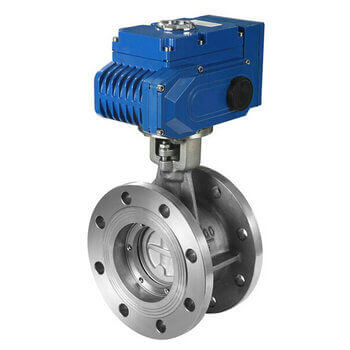Precautions for debugging and installation of butterfly valves
Butterfly valve is one of the fastest-growing valve varieties at present. The application range of butterfly valves is very wide, and the varieties and specifications continue to expand, and they are developing in the direction of high pressure, large diameter, high sealing, long life, ultra-low temperature, and ultra-high temperature. Butterfly valves can do Emergency cutoff has the characteristic of regulating flow. And it has partially replaced gate valves, globe valves and ball valves, and has become more and more important in pipelines, and its applications have become

D943H-16C-metal seated stainless steel electric triple offset butterfly valve
more and more extensive, becoming the choice of many end users. This article talks about the debugging and installation of the butterfly valve.
1. Debugging of butterfly valve
1. Whether it is a manual butterfly valve or a butterfly valve with pneumatic, hydraulic or electric actuators, it must be strictly debugged before leaving the factory. Fix it, then close the butterfly valve, apply pressure to the inlet side, and then observe whether the valve leaks on the outlet side. In the strength test of the pipeline, the butterfly plate of the butterfly valve should be opened to prevent damage to the sealing pair.
2. Although the butterfly valve has been rigorously debugged before leaving the factory, it is not ruled out that some products have loosened screws during transportation. The user needs to re-check and adjust the valve after receiving the valve. Pneumatic, hydraulic and For electric devices, please refer to the instruction manual of the supporting drive device.
3. When the electric butterfly valve leaves the factory, the opening and closing strokes of the electric control mechanism have been adjusted. But to be safe, to prevent the wrong direction when the power is turned on, after the user gets the valve and turns on the power for the first time, first manually open the valve to the half-open position, and then press the electric switch to check whether the direction of the indicator plate is consistent with the closing direction of the valve That’s it.
Second, the installation of the butterfly valve
1. Before the butterfly valve is installed, it is necessary to confirm whether the performance of the product and the arrow of the medium flow direction are consistent with the working conditions and parameters of the medium in the pipeline. The inner cavity of the valve must be clean. Never close the butterfly plate before cleaning, so as not to damage the sealing ring.
2. To install the matching flange of the butterfly valve to the clip, a special flange for the butterfly valve is required.
3. The best installation position of the butterfly valve on the pipeline is vertical installation, and inverted installation is not allowed.
4. When the butterfly valve needs to be used to adjust the flow, use the turbine box for control.
5. For butterfly valves that are frequently opened and closed, it is necessary to open the turbine box cover regularly (about two months) to check whether the butter is normal, and to ensure an appropriate amount of butter.
6. Regularly check all parts of the valve, and promptly remove any faults found.
TH Valve is a professional manufacturer of butterfly valve, gate valve, check valve, globe valve, knife gate valve, ball valve with API, JIS, DIN standard, used in Oil, Gas, Marine industry, Water supply and drainage, fire fighting, shipbuilding, water treatment and other systems, with Nominal Diameter of DN50 to DN1200, NBR/EPDM/VITON, Certificates & Approvals: DNV-GL, Lloyds, DNV, BV, API, ABS, CCS. Standards: EN 593, API609, API6D
Related news/knowledge:
Installation method and precautions of check valve
Valve installation instructions and process precautions
Precautions for installation and use of NRS gate valve
Daily maintenance and precautions of ball valves



 © Copyright 2020 Tianjin Tanghaidongyang Valve Co., Ltd. All Rights Reserved.
© Copyright 2020 Tianjin Tanghaidongyang Valve Co., Ltd. All Rights Reserved.